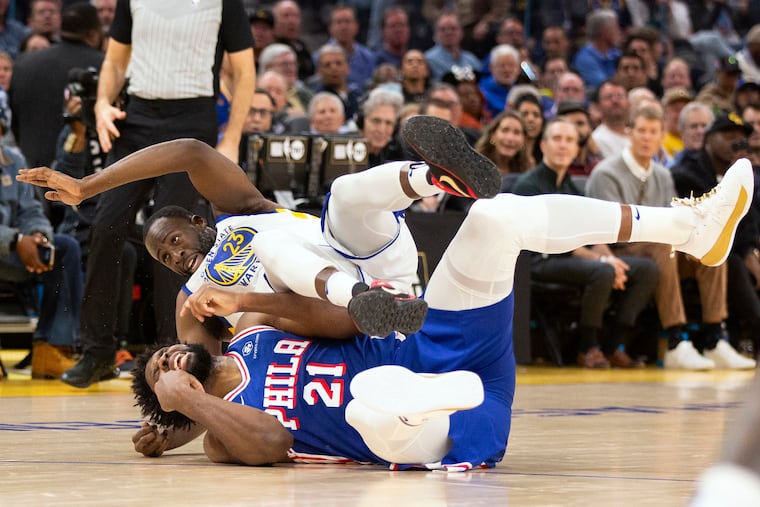What is a torn meniscus like Joel Embiid suffered?
The team has not said whether Embiid has a torn meniscus.

Sixers center and MVP contender Joel Embiid will have surgery to repair an injury to the cartilage in his left knee.
The team did not say whether Embiid tore his meniscus — an injury he has suffered multiple times in past seasons. But the Athletic reported that Embiid has been diagnosed with a displaced flap of the meniscus, which is a type of tear to the C-shaped piece of cartilage that serves as a shock absorber to the knee.
Embiid has been sidelined since the injury occurred last Tuesday. The team on Sunday said he would be out “for an extended period of time” after surgery.
Here’s what to know about meniscus injuries:
What is the meniscus?
The meniscus is C-shaped pad of cartilage that acts as a “shock absorber” at the knee. Each knee has two menisci where the thighbone and shinbone meet.
The lateral meniscus, which Embiid injured, is on the outside of the knee. The medial meniscus is on the inside.
How does a meniscus tear happen?
The menisci protect bones during physical activities on your feet. A meniscus tear typically happens when the knee is abruptly twisted or rotated.
Past meniscus injuries can weaken the knee and make it more vulnerable to twists or falls.
People who have had surgery to repair a meniscus are also at greater risk for developing arthritis, which can further weaken the joint, said Brad Bernardini, the lead physician for sports medicine at Virtua Reconstructive Orthopedics. Bernardini is not involved in Embiid’s treatment.
Embiid had surgery on his left lateral meniscus in 2017 and has experienced other knee injuries during his career — all of which could have contributed to his latest injury, Bernardini said.
Common meniscus injuries include sprains, partial tears, and full tears.
Embiid’s “displaced flap” is a type of tear, in which a piece or “flap” of cartilage separates from the meniscus, Bernardini said.
What are the symptoms of a torn meniscus?
The most common symptoms of a torn meniscus are pain, stiffness and swelling that may worsen in the following days, and limited range of motion.
People with a meniscus sprain may also experience swelling and stiffness, but will have a broader range of motion in the knee.
How is a meniscus tear treated?
It depends on how serious the injury is. Some can heal on their own, while others may require surgery to repair.
Doctors typically recommend resting the leg, using ice packs, wearing a compression bandage and elevating the leg to reduce swelling. Doctors may also recommend anti-inflammatory drugs.
There are two surgical options for more serious tears:
Repairing the tear involves reconnecting it to the meniscus. This approach requires a longer recovery, but can reduce the risk of long-term problems, such as arthritis.
Trimming off the torn part of the meniscus provides more immediate relief, but increases the risk of arthritis and future injuries, since the joint has less cushioning.
The 76ers have not said what type of surgery Embiid will have.
“His recovery will tell us which of those things was done,” Bernardini said.
Athletes often opt to remove the torn part of the meniscus because they can return to the game much quicker, potentially within six weeks, Bernardini said.
“A lot of pro athletes just want to get back,” he said.
But removing a torn area may not be an option for Embiid if the meniscus was trimmed in a previous surgery, Bernardini said. The Sixers did not detail his past surgery to the same meniscus in 2017.
How long could it take Embiid to recover from a torn meniscus?
Recovery time depends on the severity of the injury and type of surgery.
Embiid could recover within three to six weeks and potentially be back on court this season if he has surgery to trim the torn part of the meniscus, Bernardini said.
Recovery could take six to nine months if he has surgery to repair the tear.
“If it was a repair, he would not be back this season,” he said.